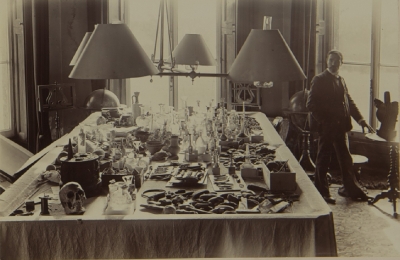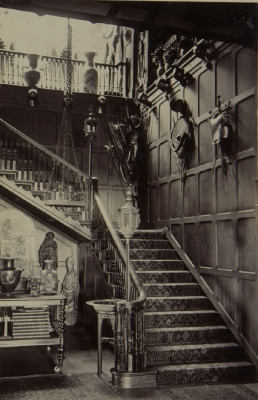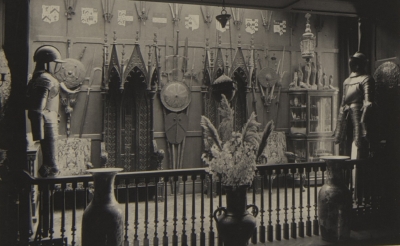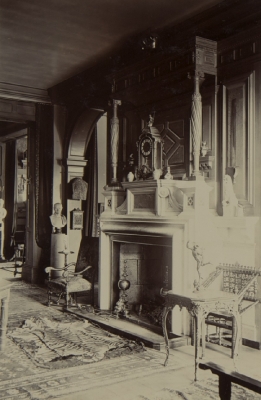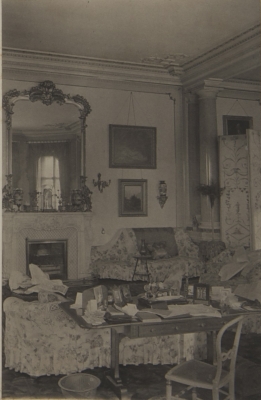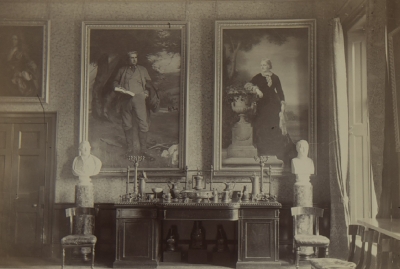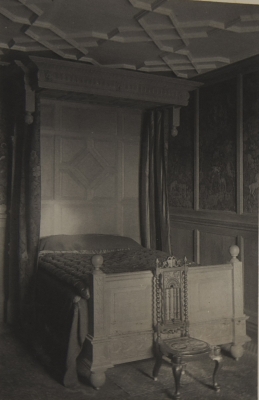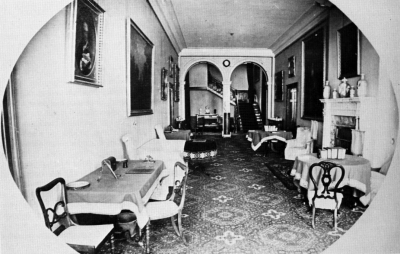This is a transcription of a short, soft-backed booklet, published around 1988, by a former master at Sandroyd School. Please note that it is likely that Sandroyd School's use of the various rooms mentioned in the text is likely to have changed over the intervening period. The photographs shown here are some of the ones shown in the book, though they are taken from the Pitt-Rivers' family photograph albums rather than scanned from the booklet.
Rushmore: Then and Now
A short history of Rushmore House and Park, at one time residence of Lieut-General A.H. Pitt-Rivers, and now the home of Sandroyd School
by Austin Caverhill, M.A.
Assistant Headmaster, Sandroyd School
Published on the occasion of Sandroyd's Hundredth Anniversary [1988]
Foreword
Sandroyd School came to Rushmore nearly fifty years ago. I remember visiting the Common Room for a drink one October evening and one of the masters asked me whether it was true that the ghost of King John and his ghostly pack of hounds still chased through the woods at dawn and dusk. "We hear them but we've never seen them", said another master. It was the feeling for history that was stimulating their imaginations. It seemed a shame to have to tell them that what they had heard was the sound of the Fallow Buck rutting in the park.
Largely thanks to Austin Caverhill, the history master and latterly the Assistant Headmaster of the school, both staff and boys know more about the country they are living in than they did in those days.
Central to an area designated officially as of "Outstanding Natural Beauty", Rushmore in Cranborne Chase has preserved much of its ancient history in the form of its extensive woods and downs.
The Pitt family built Strathfield Saye [sic] in 1620 and the second Lord Rivers sold it to the Duke of Wellington after Waterloo, and moved to Rushmore. The house remained in family occupation until my grandfather [Alexander Edward Pitt-Rivers] died in 1927, and much of my own childhood was spent there.
Mr Caverhill has now committed the wide knowledge he has acquired in the twenty five years he has been here to a booklet on Rushmore and the Chase which he describes as a glimpse into the past. He rightly claims that history is a process of discovery in the world around, and I can think of few private schools so well endowed with visions of the past as to lay the right experience for future students of the process.
I wish it well, and I trust it will be of interest and enjoyment to past, present and future Sandroydians, and perhaps a much wider readership.
Michael Pitt-Rivers
King John House
Tollard Royal
Preface
This booklet is a short account of life at Rushmore, in its earlier days the residence of a succession of woodwards, Chase Rangers and landed gentry, but now the home of Sandroyd School which at the time of writing is celebrating its Hundred Anniversary ...
Early Days [not transcribed]
The Pitt Family inherits Rushmore [not transcribed]
General Fox Lane [sic] comes to Rushmore
Let us now return to tracing how Augustus Henry Lane Fox succeeded to Rushmore. The 1714 inheritance of George Pitt made him the largest landowner in Dorset, and a not inconsiderable one in Wiltshire. He not only acquired a large part of the Chase including Rushmore, but also the King John House in nearby Tollard Royal and the manor house at Hinton St Mary, near Sturminster Newton.
The first Lord Rivers replaced the existing Rushmore Lodge with a new one in 1760, though he retained some of the offices, (Hawkins 1980). After the Enclosure Act of 1794, he was able to add a further seven hundred and seventy-six acres. Rushmore was at this time used mainly as a sporting lodge. When, however, the second Lord Rivers sold Stratfield Saye to the Duke of Wellington from funds supplied to him by a grateful nation, Rushmore House as it as now called, became the Pitt's summer residence. What was extraordinary was that Rushmore, standing in the middle of an undisturbed archaeological treasure-trove should eventually become the property of the one man in England most suited to take advantage of its unique character and earn himself the title of the Father of British Scientific Archaeology.
Though such a coincidence was remarkable, the odds against a younger son of a younger son inheriting anything of value were stacked against him. Reference to the geneological table [not included in this transcription] will, I hope, make it easier for the reader to follow the story. The first Lord Rivers had only one son, who died childless and therefore it was from one of the second Lord's three sisters that the heir would have to come. The eldest daughter, Penelope, had married Viscount Ligonier but had disgraced her family by firstly having an affair with an Italian poet, Count Alfiere and the, after the blaze of publicity following a divorce, running off with a trooper in the Blues. if she ever had any children, none was recorded.
The second daughter, Louisa, had married Peter Beckford, Master of the three packs of hounds and author of "Thoughts on Hunting", and it was their only surviving son, Horace William, [1] who became the third Lord Rivers. The fact that he had two sons, George and Horace, and thirteen grandchildren, four of whom were boys, would have seemed sufficient guarentee that the title would not pass out of the immediate family. Between 1850 and 1867, however, all four sons of George, the fourth Lord Rivers, died though the youngest of them, Henry, lived long enough to become the fifth Lord Rivers on the death of his father. It is interesting to note that the deaths of these children were ascribed to a gypsy's curse while three elder illegitimate children of the fourth Lord Rivers lived out their normal life span after emigrating to Canada. His uncle, Horace, became the sixth Lord but despite the fact he married twice, he left no heirs.
We thus go back to Marcia, the third daughter of the first Lord Rivers, to follow the line of succession. Marcia had married James Lane Fox (I am sticking to the order of Lane appearing before Fox for the sake of simplicity. The order appears interchangeable in family trees).
Under normal circumstances her elder son, George, would have inherited the title, but the second Lord Rivers who had failed to beget an heir had included in his will a clause that any Lane Fox who might inherit his own family title of Lord Bingley of Bramham should be excluded from inheriting the estates of the Rivers family. Thus it was that in 1880, as his elder brother had predeceased him, General Augustus Henry Lane Fox inherited the Rivers estates on condition he take the name of Pitt-Rivers, a name which he assumed by Royal Licence on June 4th, 1880. He was never known as the 7th Lord Rivers as the title could be applied only to the issue of Louisa's children.
Rushmore, 1880-1900
General Pitt-Rivers wasted no time in making improvements to the interior of "this not beautiful mansion from an architectural point of view but commodious -- containing some fifty rooms," (Pevsner, 1975). The interior of the building must have resounded with the noise made by carpenters who were engaged to instal the oak panelling of the main hall, stairway and the square landing on the first floor. Between four and five thousand pounds were spent on the work between 1882 and 1883 and an inscription carved on a panel going up the stairs bears witness today to its construction.
The photographs taken of the interior of the building towards the end of the century helps enormously in one's task of trying to reconstruct the life at Rushmore during the General's time. We see the billiard table covered with a variety of skulls, bones, utensils, pottery and glass in what is today the senior boys' classroom. Upstairs in what is now the surgery was what I can only describe as a shrine to chivalry. A curtain extended from one side of the stairwell to the other (the supports for the curtain rail are still in situ) and when pulled back, the viewer would behold two throne like chairs of Gothic design, medieval weaponry and, painted on the panels, the crests not only of the Pitt, Lords Rivers and Fox Lane families but those into which they are married including the Thynne, Douglas, Stanley and Grove families.
On going into the entrance hall a visitor would have seen two archways on either side of the immense fireplace. These led into the billiard room and from there a further archway (now a cupboard) gave access to the drawing room, one of the few rooms apart from the sleeping accommodation still used for its original purpose and certainly the most impressive. Between the drawing room and the library (now the base for the 3rd forms) was the original means of entering the main hall, the present porch on the West side being constructed circa 1867.
There are photographs of carriages by the steps going up to the French windows and this means of access to the building was still used in the General's time and a story was recounted to me of how, when the doors were opened, a gust of wind blew over and shattered a vase of great value. The General gave the task of piecing together the fragments to his band-master, more of whom we shall hear later.
Stories certainly abound which tell of the eccentricity of General Pitt-Rivers and his wife. He developed a tendency towards meanness judging by the many letters written to him by tradesmen complaining of unpaid bills while Mrs Pitt-Rivers is described by her Stanley nephew, Bertrand Russell, as a miser who when her Guardsman sons came down late for breakfast and requested fresh food would say that they should eat the scrapings taken from the visitors' plates who had eaten earlier. Her instructions, however, were ignored.
Cyril Adams who was later to run a taxi service in Sixpenny Handley, told me how as a boy he, with other children, attended dancing lessons in the hall and how the General would appear at the top of the stairs and bellow his dissatisfaction with the noise to his wife below who was in charge of the proceedings.
Not only did the General, his wife, six sons and three daughters occupy the mansion but the customary large number of servants was employed that was necessary for the smooth running of a Victorian household. Lady's maids, valets, housemaids, footmen, butler, underbutler, housekeeper, hall-boy, cook, kitchen, scullery and laundry-maids all had their place in this semi-feudal, almost self-supporting establishment whilst outside the house grooms, coachmen, stablelads, and a host of gardeners and estate workers carried out their particular tasks.
The original servants' hall along with the scullery, larder, still rooms, dairy and bakehouse disappeared when a new dining-hall was built in 1972 but what was the old brewery (later to become the laundry) still stands, though now converted into two residential flats. It was still in use as a laundry when the school took over the building in 1939 and Mrs Ozanne has described to me how a certain Ena Shaw did the entire school washing in the original zinc-lined teak wash-tub, while a ton of wood was burnt every week to provide the necessary hot water. Certainly this atmosphere of feudal self-sufficiency lasted well into the 1950's as the teaching staff still chopped the wood used for the heating of their rooms.
The Pitt-Rivers' occupancy of the house has also left its mark with their naming of the principal bedrooms. Though most of the dormitories now have names that are of Sandroyd origin there will be those Old Boys who remember when their dormitory was called Landscape, Turf, East, North, Pilgrims or Maple. Brass plaques are still clearly visible above doorways of many of these bedrooms. Today boys still use a bathroom called "Guards" perhaps not knowing that Guards bedroom and dressing-room were next to it. Interestingly enough, there is a lady teacher's weekend duty called "Red Room" duty, without there being a "Red" Room in the building. This particular name was transferred with the school from Cobham as the traditional name for the smallest boys' classroom.
During the twenty years of the General's occupancy of Rushmore not only was the park surrounding the house transformed but so was the development of archaeology in this country. [There follows a short description of Pitt-Rivers' archaeological career]...
Once at Rushmore he organized his army of estate workers with military efficiency and carried out his excavations with a far more systematic and scientific manner than had ever been previously attempted. ...
For General Pitt-Rivers then, it was going to be the doctrine of evolution, not revolution that would bring about social progress, but that would only be possible through education. Therefore the next stage was to transform Rushmore Park and its environs into a centre for the education of the masses, (Bowden, 1984).
The Pitt-Rivers Museum that was to house his collection and was to be the principal means of enlightening the minds of the ordinary people was established in an old gypsy school but how was he going to attract people to it? The means by which he hoped to do so was surely the first of its kind in the country. Not only was every facility provided for the visitor at Larmer Tree Grounds in Tollard Royal, but there was also an eighteen hole golf course that started from the race track (also built by the General), that went as far as Minchington Cross, back to just below South Lodge, then across the Tollard Royal Road, and back to the Race Course.
Inside Rushmore Park visitors could see exotic animals such as llamas, emus, rheas and kangaroos. The General also cross-bred Highland and Jersey cows with the humped back Zebu cattle from India. The result, he discovered, was an animal that had a quicker walking pace than the native ones but was undeniably treacherous. He even brought reindeer into the park to see if they could be acclimitised but they survived for three years only, finding the climate to be too warm!
Traces today of this earliest of game parks are now hard to find. The animals used to gather at the pond near Home Farm, now Mr Brown's house, and were photographed grazing by Whitehazel Cottage. Rectangular and circular drinking troughs can still be seen in the open area near Park Cottage.
Eight miles of new fencing was erected to enclose these animals (as well as the deer) and picturesque lodges were erected at the entrances to the North and South Drives, as well as Bridmore Lodge to the East. Two drives reached the house from both North and South Lodges, one being reserved for tradesmen.
Opposite North Lodge the Jubilee Hall was built in 1887 (Queen Victoria's Golden Jubilee Year) and was originally reluctantly provided by the General as a place of worship for his employees. ... This singular building was erected a good fifteen minutes walk from the main house and uphill too, but it did serve the outdoor servants as well as those of the domestic household. [2]
In contrast to the building of this chapel was the erection in 1890 of a Temple dedicated to Vesta (of Vestal Virgin fame) at a cost of £1,792. This was to commemorate the birth of the the General's first grandson. It consists of eighteen fluted columns of Bath stone surmounted by Corinthian capitals. The dome is of copper, (Pevsner, 1975). Sixteen workmen from the estate were pressed into service to form the original band after three weeks intensive training under the supervision of Band-sergeant Spencer of the Grenadier Guards. The band became one more attraction to the area, playing both in the park and at the Larmer Tree Grounds.
Miss Elsie Pike, an elderly niece of Mr Inkpen, the aforementioned bandmaster, related to me how he had been forbidden by the General to play any hymn-tunes. One afternoon the General, thinking he had caught Mr Inkpen disobeying his order, rushed up to him shouting, "I won't have it! I won't have it! That's a hymn you're playing!"
"You're mistaken, Sir," replied the quick-thinking Mr Inkpen, "It's a new piece called "The Devil's All Around Us'!"
"Oh, in that case, you may carry on," said the General. "It sounds a fine tune."
Space does not allow me to write more of Rushmore at this time. General Pitt-Rivers died on May 4th, 1900, aged 73, and with typical eccentricity had given instructions that his remains be cremated at Woking and that a post mortem be made so that any items of particular scientific interest concerning his constitution or peculiarities in his "cerebral convolutions" could be noted, (Hawkins, 1980). His actual brain was left to posterity but unfortunately its repository in London was bombed during World War II and the skull with its contents was destroyed. [3]
Rushmore, 1900-1939
His heir, Alexander, was living at Hinton St Mary at the time of his father's death and as a result Rushmore was let for the next three years. When Alexander wished to repossess the house he had difficulty in persuading the tenant to leave. After much mutual ill feeling had been generated, the tenant vacated the property and a garden party was held at Rushmore to celebrate Alexander's return. The words "Blackguard Landlord" became apparent on the main lawn after the party. They had been inscribed in weed killer before the tenant left and only then became apparent. The tenant was promptly sued for libel and in the protracted court case that followed Alexander was eventually awarded damages of one shilling (5p) but had, according to his grandson, [4] the immense satisfaction of bankrupting his opponent.
During the 1914-18 War, Rushmore House was turned into a convalescent home for soldiers wounded on the Western Front (thus providing more ghosts to people the dormitories at night). An elderly resident by name of Mrs Lucas, from nearby Dean, sadly now deceased, had been in domestic service at Rushmore during this time. She described to me how she had had to polish the main hall, now called "The Middle" on her hands and knees -- no electric polishers in those days! ...
Her father had been head-gardener to the General and she remembered as a five-year old how she had stood, holding her mother's hand watching Mrs Pitt-Rivers in her carriage going down South Drive past the kitchen-gardens. Shortly after it passed them it stopped and they were both summoned to Mrs Pitt-Rivers' presence.
"Your daughter is old enough to curtsey now when the carriages go by. Please see it is done," instructed Mrs Pitt-Rivers to her mother.
Rushmore ceased to be lived in by the Pitt-Rivers family in 1927 and in 1930 it was rented by Colonel W. LeWellyn [sic] Palmer and his family until 1937 and fifteen of the fifty rooms were cut off from the rest of the house. ... [A description of the life of Lady Palmer's personal maid is described her but not transcribed]
When the Palmer's lease came to an end, the fate of Rushmore Lodge was in the balance. Nearby Chettle House would eventually be turned into flats; both Ferne and Langton House have disappeared altogether. The threat to peace posed by Nazi Germany, however, decided Rushmore's future. The owner of a school called Sandroyd in Cobham, Surrey, was considering the possibility of a move to the West Country.
... Among [the possibilities] was to be Rushmore House! Mr Ozanne [owner and headmaster of the school] went straight over to look at the property, and on March 28th, 1939, a short lease was negotiated, with an option to take a long lease if war did indeed break out.
... The General would surely have approved, under the circumstances, of this trainload of youngsters who, having been obliged to vacate one of the best appointed buildings of its kind, was journeying to a house set in thousands of acres of unspoilt countryside. He would have remembered the excitement that he felt when he first made the journey to Rushmore.
Sandroyd at Rushmore
... changes had to be made. The hall became a classroom as did the square landing above, though on a temporary basis, and blankets were draped at suitable intervals to deaden the noise. The billiard room, library and morning room were converted to classrooms and remain so today. Even the aviary was transformed, having been converted into the boys' lavatories.
Thus the house's life and the school's life were co-mingled and preserved in the process.
... in 1955, on his retirement, Mr Ozanne handed the administration of the school over to an Educational Trust to be operated by a Board of Governors. ...
... In 1967 the Governors were able to purchase Rushmore House outright, as well as the staff houses and playing fields. There had been serious outbreaks of dry rot and as the Pitt-Rivers Estate was responsible for repairs to the fabric of the building, the sale of the house to the school for £25,000 was welcomed on both sides. Thus 250 years of ownership by various members of the Rivers family came to an end. ...
Notes [added by transcriber]
[1] Most sources give this name as William Horace Beckford later Pitt-Rivers
[2] Other sources describe the Jubilee Room as a reading room and a photograph in the family photograph albums seems to support this use.
[3] See here for more information about Pitt-Rivers' head, 'The Headless Body'.
[4] Presumably he means Michael Pitt-Rivers, who was in fact his great-grandson?
Transcribed by AP June 2012
